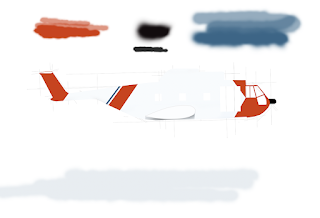On a pure aesthetic value, I would not have picked the HH-3F to draw. It's ugly. But, celebrating physical beauty is not the point of my work. Attractive or not, the aircraft depicted in this blog represent something (to me at least) far, far, far beyond 'the machine.'
I'm not terribly religious, certainly not holy. But — as ridiculous as this might sound to some — there's something of the Divine in each of my experiences "interviewing old guys and drawing their airplanes." A few years ago, one of my business mentors stated that I may have been rendered 'unemployable' on account of hanging out with so many remarkable people. As I'm still convinced I'm largely a coward with an outsized ego, I'll always find work.
Nevertheless...
I have been deeply affected by the stories, friendships, and examples that these drawings represent.
* break break *
This particular HH-3F "Pelican" is being drawn for an event that'll happen this Fall. Media might even show up, so it's possible the finished piece could make the news. We'll see about that — if it does, check my Facebook page sometime after October 1, 2025.
On a personal level, this Pelican is fascinating for a number of reasons:
1. It's military, but not martial. (not everyone wants to see guns/missiles)
2. It's no longer in service. (the last Pelican in Coast Guard service was retired in 1994)
3. It's unique (it could land/takeoff from the water)
4. It's painted with orange (no "SEA Camo" here!)
5. It represents an amazing story that has captured my imagination a hundred times... *snap! snap! earth to John, earth to John!* (distractions also make one unemployable).
Anyway.
A little bit of background on the HH-3F Pelican is in order. Have a look at the pictures below.
 |
An S-61 (civilian version of the SH-3) helicopter from photographer Chen Peng, courtesy Wikipedia. Notice the fuselage - it's shorter, stockier than the S-61R/HH-3 version |
The naming & production convention behind the S-61/H-3 helicopter series is an alphabet soup to those unfamiliar with how industry and government develop things. Civilian markets get one name, military gets another. But suffice it to state, the Pelican was derived from a late 1950s U.S. Navy request for a helicopter that could perform anti-sub, search and rescue (SAR) and general-purpose roles. The result was the very successful S-61/SH-3.
The USAF noticed the success of the SH-3 and wanted one of their own. Contrary to public opinion that the military industrial complex runs around willy-nilly spending money — especially during the McNamara years of 'efficient' government procurement — the USAF realized it'd be cheaper/faster to adapt the SH-3 to their needs than develop something brand-new. Thus, the S-61R/CH-3E was developed. Essentially, the C/HH-3E was an S-61 modified to have a loading ramp.
Have a look again at the photos above — they're very different but very similar machines. If you're really into geeking-out about the S-61 series of helicopters, try these links: S-61 and S-61R. Take your time though - the two helicopters are often confused in print AND web. Regardless, the basic S-61 design generated fifteen variations expressed in a total production run of 794 helicopters.
Ugly? Sure. Successful? Undoubtedly.
Going just a bit deeper, a few more facts on the HH-3F Pelican version:
Length: 57' feet
Width: 16'
Top speed: 160mph
Hover altitude: ~6500ft; Service ceiling (horizontal flight) 10,500ft
Range: 750 miles
Crew: 5 - pilot, co-pilot, 2x aircrew, rescue swimmer
**************
Enough waxing philosophical. Enough background on the helicopter itself.
Let's see what we can learn from this particular HH-3F, flown by one particular pilot, on one particular day. As it's good to keep all of us employed, I'll save posting the Distinguished Flying Cross citation until after the presentation event as it might send you into a day-long daydream.
But... a little bit of teasing won't hurt.
The picture above was swiped from a site called "Blue Water Mystique." Apparently, this photo was taken during sea conditions that generated 30'-40' waves. The graph below shows the "Beaufort Wind Scale" that's used to categorize wind:storm affect on ocean conditions.
Have a look, pay attention to the Force column, eye-down to #11, classification: Violent Storm.
Now. Imagine this - you've just put in 4 intense hours flying SAR missions over stormy seas and you get ANOTHER call to action... this time, nearly twenty people are caught in conditions of 40' + waves, 60knot winds and your job is to hold hover in the torrential sea-spray, and haul the hapless up (one at a time) and take them home.
If you're like me, thinking about the moment makes any office/work/executive 'work' currently going on seem utterly insignificant.
But I betcha it'll inspire me to give more of my best to whatever office/work/executive thing I've got going on and appreciate the CAVU** skies and calm winds right outside my window.
More to come (back to work).
 |
The pencil-sketch I did when given the GO! on this project. |



















